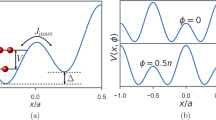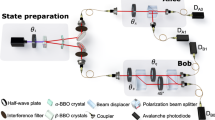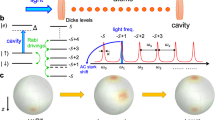Abstract
The Greenberger–Horne–Zeilinger (GHZ) states1 play a significant role in fundamental tests of quantum mechanics2 and are one of the central resources of quantum-enhanced high-precision metrology3, fault-tolerant quantum computing4 and distributed quantum networks5. However, in a noisy environment, entanglement becomes fragile as the particle number increases6,7,8. Recently, a concatenated GHZ (C-GHZ) state, which retains the advantages of conventional GHZ states but is more robust in a noisy environment, was proposed9. Here, we experimentally prepare a three-logical-qubit C-GHZ state. By characterizing the dynamics of entanglement quality of the C-GHZ state under simple collective noise, we demonstrate that the C-GHZ state is more robust than the conventional GHZ state. Our work provides an essential tool for quantum-enhanced measurement and enables a new route to prepare and manipulate macroscopic entanglement. Our result is also useful for linear-optical quantum computation schemes whose building blocks are GHZ-type states.
This is a preview of subscription content, access via your institution
Access options
Subscribe to this journal
Receive 12 print issues and online access
$209.00 per year
only $17.42 per issue
Buy this article
- Purchase on Springer Link
- Instant access to full article PDF
Prices may be subject to local taxes which are calculated during checkout




Similar content being viewed by others
Change history
20 April 2014
In the version of this Letter originally published in print, the following mathematical expressions were formatted incorrectly. On page 1, column 1, paragraph 2, line 2, the two symbols "N" should not be superscripted relative to the symbol "⊗". The correct expression is (|0〉⊗N + |1〉⊗N)/√2. Similarly, equation (1) should appear as |ϕ±N,m〉 = (|GHZ+m〉⊗N ±|GHZ−m〉⊗N)/√2. On page 1, column 2, paragraph 1, line 3, the two symbols “m” should not be superscripted relative to the symbol "⊗". The correct expression is (|0〉⊗m ± |1〉⊗m)/√2. In equation (2), the two symbols “3” should not be superscripted relative to the symbol "⊗". The correct expression is |ϕ+3,2〉 = (|Φ+〉⊗3 + |Φ−〉⊗3)/√2 = (|HHHHHH〉 + |HHVVVV〉 + |VVVVHH〉 + |VVHHVV〉)231456/2. In the expression for Uθ appearing on page 4, column 1, paragraph 3, line 5, the symbol "y" should be subscripted relative to the symbol "σ". The correct expression is Uθ = . These typographical errors have been corrected in both the HTML and PDF versions of this Letter.
References
Greenberger, D. M., Horne, M. A. & Zeilinger, A. in Bell's Theorem, Quantum Theory, and Conceptions of the Universe 69–72 (ed. Kafatos, M.) (Kluwer, 1989).
Pan, J.-W. et al. Multiphoton entanglement and interferometry. Rev. Mod. Phys. 84, 777–838 (2012).
Giovannetti, V., Lloyd, S. & Maccone, L. Quantum-enhanced measurements: beating the standard quantum limit. Science 306, 1330–1336 (2004).
Varnava, M., Browne, D. E. & Rudolph, T. How good must single photon sources and detectors be for efficient linear optical quantum computation? Phys. Rev. Lett. 100, 060502 (2008).
Zhao, Z. et al. Experimental demonstration of five-photon entanglement and open-destination teleportation. Nature 430, 54–58 (2004).
Dür, W., Simon, C. & Cirac, J. I. Effective size of certain macroscopic quantum superpositions. Phys. Rev. Lett. 89, 210402 (2002).
Dür, W. & Briegel, H.-J. Stability of macroscopic entanglement under decoherence. Phys. Rev. Lett. 92, 180403 (2004).
Aolita, L., Chaves, R., Cavalcanti, D., Acín, A. & Davidovich, L. Scaling laws for the decay of multiqubit entanglement. Phys. Rev. Lett. 100, 080501 (2008).
Fröwis, F. & Dür, W. Stable macroscopic quantum superpositions. Phys. Rev. Lett. 106, 110402 (2011).
Yao, X.-C. et al. Observation of eight-photon entanglement. Nature Photon. 6, 225–228 (2012).
Monz, T. et al. 14-qubit entanglement: creation and coherence. Phys. Rev. Lett. 106, 130506 (2011).
Huelga, S. F. et al. Improvement of frequency standards with quantum entanglement. Phys. Rev. Lett. 79, 3865–3868 (1997).
Raussendorf, R. & Harrington, J. Fault-tolerant quantum computation with high threshold in two dimensions. Phys. Rev. Lett. 98, 190504 (2007).
Zanardi, P. & Rasetti, M. Noiseless quantum codes. Phys. Rev. Lett. 79, 3306–3309 (1997).
Lidar, D. A., Chuang, I. L. & Whaley, K. B. Decoherence-free subspaces for quantum computation. Phys. Rev. Lett. 81, 2594–2597 (1998).
Shor, P. W. Scheme for reducing decoherence in quantum computer memory. Phys. Rev. A 52, R2493–R2496 (1995).
Laflamme, R., Miquel, C., Paz, J. P. & Zurek, W. H. Perfect quantum error correcting code. Phys. Rev. Lett. 77, 198–201 (1996).
Bennett, C. H., DiVincenzo, D. P., Smolin, J. A. & Wootters, W. K. Mixed-state entanglement and quantum error correction. Phys. Rev. A 54, 3824–3851 (1996).
Kwiat, P. G. et al. New high-intensity source of polarization-entangled photon pairs. Phys. Rev. Lett. 75, 4337–4341 (1995).
Raussendorf, R. & Briegel, H. J. A one-way quantum computer. Phys. Rev. Lett. 86, 5188–5191 (2001).
Hofmann, H. F. & Takeuchi, S. Quantum phase gate for photonic qubits using only beam splitters and postselection. Phys. Rev. A 66, 024308 (2002).
Langford, N. K. et al. Demonstration of a simple entangling optical gate and its use in Bell-state analysis. Phys. Rev. Lett. 95, 210504 (2005).
Kiesel, N., Schmid, C., Weber, U., Ursin, R. & Weinfurter, H. Linear optics controlled-phase gate made simple. Phys. Rev. Lett. 95, 210505 (2005).
Okamoto, R., Hofmann, H. F., Takeuchi, S. & Sasaki, K. Demonstration of an optical quantum controlled-NOT gate without path interference. Phys. Rev. Lett. 95, 210506 (2005).
Hofmann, H. F. Complementary classical fidelities as an efficient criterion for the evaluation of experimentally realized quantum operations. Phys. Rev. Lett. 94, 160504 (2005).
Bourennane, M. et al. Experimental detection of multipartite entanglement using witness operators. Phys. Rev. Lett. 92, 087902 (2004).
Gühne, O., Lu, C.-Y., Gao, W.-B. & Pan, J.-W. Toolbox for entanglement detection and fidelity estimation. Phys. Rev. A 76, 030305 (2007).
Dür, W., Cirac, J. I. & Tarrach, R. Separability and distillability of multiparticle quantum systems. Phys. Rev. Lett. 83, 3562–3565 (1999).
Acknowledgements
This work was supported by the National Natural Science Foundation of China, the CAS, the National Fundamental Research Program (grant no. 2011CB921300).
Author information
Authors and Affiliations
Contributions
H.L., L.-K.C., N.-L.L., Y.-A.C. and J.-W.P. conceived and designed the experiments. H.L., L.-K.C., C.L., P.X., X.-C.Y. and L.L. carried out the experiments. All authors analysed the data and wrote the paper. N.-L.L., Y.-A.C. and J.-W.P. supervised the whole project.
Corresponding authors
Ethics declarations
Competing interests
The authors declare no competing financial interests.
Supplementary information
Supplementary information
Supplementary information (PDF 512 kb)
Rights and permissions
About this article
Cite this article
Lu, H., Chen, LK., Liu, C. et al. Experimental realization of a concatenated Greenberger–Horne–Zeilinger state for macroscopic quantum superpositions. Nature Photon 8, 364–368 (2014). https://doi.org/10.1038/nphoton.2014.81
Received:
Accepted:
Published:
Issue Date:
DOI: https://doi.org/10.1038/nphoton.2014.81
This article is cited by
-
Efficient generation protocol for the three-level logical entangled states
Quantum Information Processing (2022)
-
Quantum error rejection for faithful quantum communication over noise channels
Science China Physics, Mechanics & Astronomy (2019)
-
Logic Bell state concentration with parity check measurement
Frontiers of Physics (2019)
-
Construction of quantum gates for concatenated Greenberger–Horne–Zeilinger-type logic qubit
Quantum Information Processing (2018)
-
Electronic Entanglement Concentration for the Concatenated Greenberger-Horne-Zeilinger State
International Journal of Theoretical Physics (2017)



